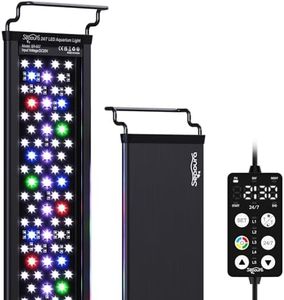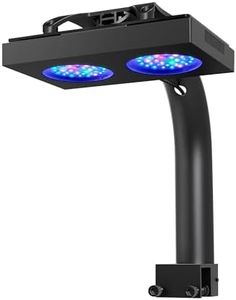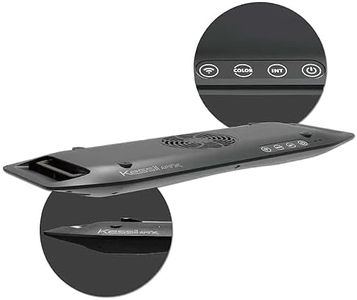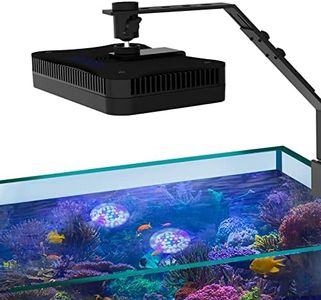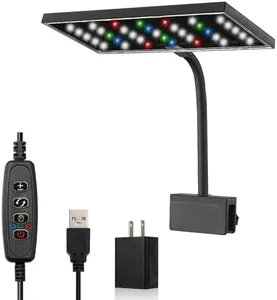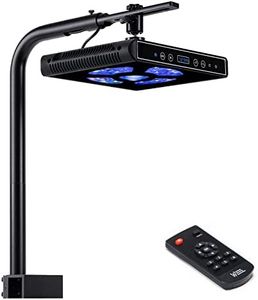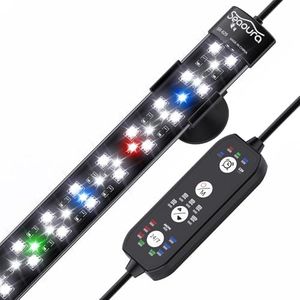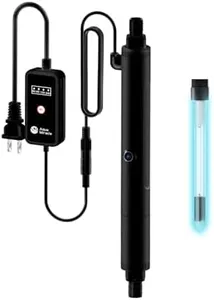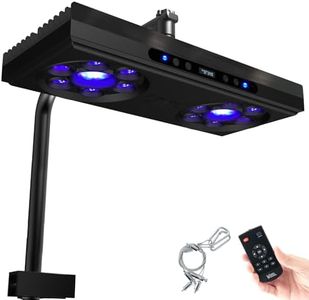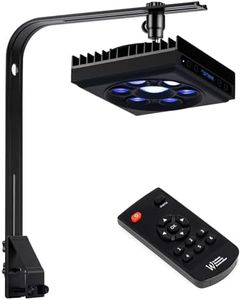10 Best Reef Tank Led Lights 2025 in the United States
Our technology thoroughly searches through the online shopping world, reviewing hundreds of sites. We then process and analyze this information, updating in real-time to bring you the latest top-rated products. This way, you always get the best and most current options available.

Our Top Picks
Winner
NICREW HyperReef 150 Gen 2 Reef LED Light, 150W Reef Aquarium Lighting for SPS LPS Corals and Saltwater Fish Tanks, Enhanced Violet and Blue Spectrum, Wide Angle Lens, 5 Channels Fully Programmable
Most important from
85 reviews
The NICREW HyperReef 150 Gen 2 Reef LED Light is designed to provide an optimal environment for SPS and LPS corals as well as saltwater fish. The enhanced violet and blue spectrum ensures the right wavelengths for coral growth and fluorescence, which is essential for maintaining a healthy reef tank. With a powerful 150W output, it delivers ample lighting for a variety of tank setups. The custom wide-angle optical system achieves extensive coverage and even PAR distribution, which helps to eliminate hotspots and promote uniform coral growth across the tank.
The advanced heat management system, which includes a new fan and redesigned heatsink, ensures efficient heat dispersion with minimal noise, making it a quieter option for your tank setup. This model also features 2 USB-C control ports for connecting to an external controller (sold separately), allowing for extensive customization of light settings. Various mounting options, including single light mounting arms and hanging kits, offer flexibility in installation.
There are a couple of considerations. The need for an external controller for full customization might be an extra expense for some users. Additionally, at 8.5 pounds, it is relatively heavy, which might necessitate sturdier mounting solutions. The NICREW HyperReef 150 Gen 2 is a strong contender for reef tank enthusiasts looking for powerful, customizable, and efficient lighting solutions with wide coverage and effective heat management.
Most important from
85 reviews
Kessil AP9X LED Aquarium Light
Most important from
28 reviews
The Kessil AP9X LED Aquarium Light is a strong contender for reef tank enthusiasts, especially those managing mixed and SPS reef setups. With a powerful output of 180 watts, it effectively covers areas of up to 4 feet by 2 feet for mixed reefs and 3 feet by 2 feet for SPS. This makes it versatile for various tank sizes, ensuring that your corals receive adequate light for growth and vibrancy.
One of its standout features is the improved light spectrum that includes a new Violet Channel, which enhances coral colors and promotes better growth. The built-in Wi-Fi and redesigned app interface allow for detailed control over the lighting settings, making it easy to optimize your reef tank's conditions from your smartphone.
The AP9X is also designed with user-friendliness in mind; its lightweight and lower profile design make installation straightforward, especially with the optional Kessil mounting arm. This arm has swivel capabilities for better light positioning, which is beneficial for reducing shadows and ensuring even coverage. However, the mounting arm is sold separately, which adds to the initial cost of setting up the light. While the app provides comprehensive control, some users may find the learning curve a bit steep if they're not familiar with smart lighting technology.
Most important from
28 reviews
Lominie Aquarium LED Reef Light Coral WiFi Control 135W Programmable Saltwater Aquarium Light Full Spectrum for Marine Fish Tank with Stand
Most important from
1531 reviews
The Lominie Aquarium LED Reef Light Coral WiFi Control 135W is a versatile and powerful lighting option for reef tanks. It offers a full spectrum of colors, including blue, royal blue, white, UV, red, and green, which can enhance the appearance of corals and marine life. With 96 individual LEDs and a 90-degree lens, it provides uniform illumination and strong light penetration, which is essential for photosynthesis in corals (PAR).
The 135W wattage offers ample power for most home aquariums, and the adjustable bracket makes it suitable for both rimmed and rimless tanks ranging from 48” to 59” in size. The integrated WiFi control and RF remote allow for easy customization of the light spectrum and intensity, with four dimmable channels that can be adjusted from 0% to 100%, and programmable settings for different times of day. This flexibility can help create an optimal environment for different types of marine life.
The cooling system, which includes an aluminum heatsink and a self-monitoring fan, keeps the operating temperature below 50℃ and ensures silent operation with noise levels under 38db. This can be particularly important in maintaining a stable tank environment and avoiding stress for aquatic inhabitants. However, there are some drawbacks. The light's dimensions, while compact, may not cover very large tanks effectively without multiple units. Additionally, while the WiFi functionality adds convenience, setting it up might be challenging for some users. The waterproof feature is a significant plus, but the overall weight of 6.05 pounds might require sturdy mounting. This product is best suited for aquarium enthusiasts who prioritize customizable lighting and are comfortable with tech features like WiFi control.
